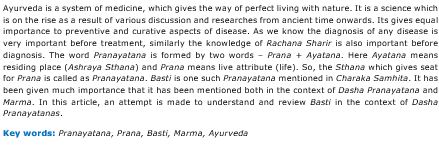A conceptual review of Basti (Urinary Bladder) as Pranayatana
Keywords:
Pranayatana, Prana, Basti, Marma, AyurvedaAbstract
Ayurveda is a system of medicine, which gives the way of perfect living with nature. It is a science which is on the rise as a result of various discussion and researches from ancient time onwards. Its gives equal importance to preventive and curative aspects of disease. As we know the diagnosis of any disease is very important before treatment, similarly the knowledge of Rachana Sharir is also important before diagnosis. The word Pranayatana is formed by two words – Prana + Ayatana. Here Ayatana means residing place (Ashraya Sthana) and Prana means live attribute (life). So, the Sthana which gives seat for Prana is called as Pranayatana. Basti is one such Pranayatana mentioned in Charaka Samhita. It has been given much importance that it has been mentioned both in the context of Dasha Pranayatana and Marma. In this article, an attempt is made to understand and review Basti in the context of Dasha Pranayatanas.
Downloads
References
Dr.Govind Bhaskar Ghranekar, Sushruta Samhita (Sharira Sthana), Meharchand Lachhamandas Publication, New Delhi; 2017, Page No-104.
Dr.Brahmanand Tripathi, Charak Samhita, Sutra Sthana, Varanasi: Chaukhamba Surbharati Prakashan; 2013; Page No-553.
Dr.Brahmanand Tripathi, Charak Samhita, Sutra Sthana, Varanasi: Chaukhamba Surbharati Prakashan; 2013; Page No-924.
Dr.Brahmanand Tripathi, Astanga Hridaya, Sharira Sthana, Varanasi: Chaukhamba Surbharati Prakashan; 2012; Page No-368.
Dr.Govind Bhaskar Ghranekar, Sushruta Samhita (Sharira Sthana), Meharchand Lachhamandas Publication, New Delhi; 2017, Page No-184.
P.V Sharma, Charak Samhita, Siddhi Sthana, Chaukhamba Orientalia,Varanasi; 2014, Page No-647.
Prof.G.D.Singhal, Sushruta Samhita, Nidana Sthana, Chaukhamba Sanskrit Pratisthan, Varanasi, 2007, Page No-526.
P.V Sharma, Charak Samhita, Siddhi Sthana,Chaukhamba Orientalia,Varanasi; 2014, Page No-645.
Prof.G.D.Singhal, Sushruta Samhita, Sharira Sthana, Chaukhamba Sanskrit Pratisthan, Varanasi, 2007, Page No-79.
Gerard J. Tortora, Principle of Anatomy and Physiology, 12th Edition;2009, Page No-1050.
BD Chaurasia, Human Anatomy Regional and Applied, 8th Edition, New Delhi, CBC Publisher and Distributers, 2020, Vol-1, Page No-375.















